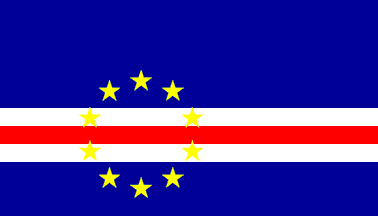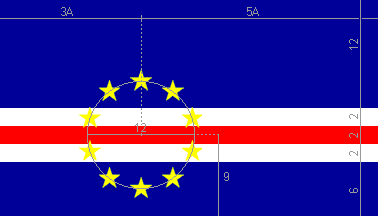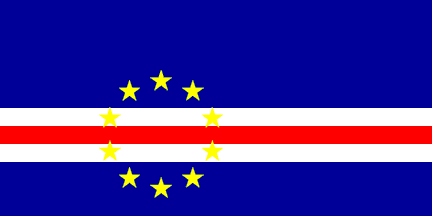
Last modified: 2006-03-18 by antonio martins
Keywords: cabo verde | stars: ring | star: 5 points (yellow) | stars: 11 | law | ratio: ambiguous | sea | sky | island | unity | effort | peace | construction | road | compass | helm | world map | horizon |
Links: FOTW homepage |
search |
disclaimer and copyright |
write us |
mirrors

A new flag was adopted on 22 Sep 1992, when Cape Verde finally severed its links with Guinea-Bissau. The new flag has 10 stars representing the islands, set in a blue sea. Prior to 1992, the similarity between the two nations’ flags was explained by the fact that both were derived from the flag of the Partido Africano da Independência da Guiné e Cabo Verde (P.A.I.G.C.), the liberation movement which succeeded in gaining independence for both countries (Guinea-Bissau in 1974, Cape Verde in 1975). P.A.I.G.C.’s aim had been that the two nations should unite, but this merger was scotched in 1980 by a military coup in Guinea-Bissau.C. Veale, quoting [dev94]

The Constitution of the Republic of Cabo Verde (Green Cape Islands),
adopted in 1992, defines the new flag, very different from the
previous (wich was similar to the
Bissau-Guinea flag, for historical reasons),
and said by some to be very “unafrican”.
Article 8th
(...)
2. The National Flag is made up of five rectangles stacked along its length.
The upper and lower rectangles are blue, being the upper one half of the flag area and the lower one forth.
Separating the two blue rectangles, three stripes each being one 12th of the flag area.
The stripes adjoining the blue rectangles are white and the one between is red.
Over the five rectangles, ten yellow five pointed stars, with the upper apex in the 90 degree position, define a circle which center lies in the intersection of the middle line of the second vertical quarter, counted from the left with the middle line of the second horizontal quarter, counted from the lower edge. The star nearer from this edge is set inside an invisible circle which center lies on the middle line of the lower blue stripe.
Confused? Good — the original is also very “unclear”, to say the least. I’ll try a more clear and concise description:
Over a field of horizontal unequal stripes (from the top: blue, 6 twelveths of the flag’s height; white, 1 twelveth of the flag’s height; red, 1 twelveth of the flag’s height, white, 1 twelveth of the flag’s height; blue, 3 twelveths of the flag’s height), a circle of ten yellow five-pointed stars pointing upwards, with radius of 1/4 of the flag’s height and center 3/8 of the flag’s width from the hoist and 3/8 of the flag’s height from the bottom edge. (Stars’ sizes not specified, neither are the color shades.)
António Martins, 19 May 1997 and 29 Mar 2002
The size of the stars is also not mentioned. As all the images I have seen
show the stars somewhat “entering” the red stripe, they must be inscribed in
circles with diameter larger than exactly 1/12 of the flag’s height, perhaps
1/10 of the flag’s height.
Željko Heimer, 28 Apr 2001
I just saw on a large photo taken outside the City Hall of São
Filipe (Fogo island) the national flag of Cape Verde. The stars are clearly
Y+, “dark” yellow, with clear contrast on the white areas.
António Martins, 30 Nov 2003
Note that the discription only refers to areas and
heights and uses
independent horizontal and vertical measurements; that means that no fixed
proportions are specified — such a description could aply to a 1:2, 2:3,
1:1 or most other flag formats!
António Martins, 19 May 1997

This was also the case of the previous flag:
The Constitutions of both Cape Verde and Bissau-Guinea
prescribed "three equal area rectangles, one vertical to the hoist and two
horizontal to the fly", but Cape Verde had a 2:3 flag (each rectangle being
1×2) and Bissau-Guinea had a 1:2 flag (vertical rectangle 6×4 and
horizontal rectangles 3×8).
António Martins, 19 May 1997
Unless any of the authors above can give a source for those values
(which I doubt, considering their disparity), I believe that they are not
the ratio(s) prescribed by a lesser and more detailed law, but rather
(mis)measurements of real flags, manufactored under the legal license of
no fixed ratio.
António Martins, 24 Jan 2001
.gif)
As on the flag, the stars represent the main islands
of Cape Verde; the plumb-bob is symbolic of rectitude and virtue; the torch
and triangle represent unity and freedom.
Ivan Sache, 21 Jan 2001